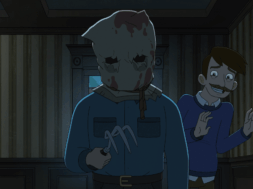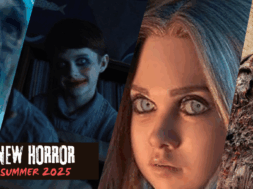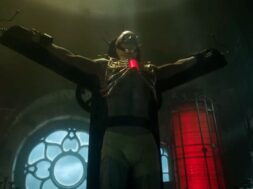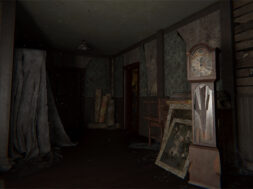William Peter Blatty’s misunderstood and maligned Exorcist sequel came out almost 30 years ago and is frightening people now more than ever.
“Friends…Old friends…”
Sequels are always a hard prospect in general, but they’re even more of a daunting task when the original film that they follow is a masterpiece and has a legendary reputation. William Friedkin’s The Exorcist isn’t just considered to be one of the scariest and greatest horror movies, but it’s also seen as one of the best films of all time, period. Sometimes the prospect of financial and commercial success can weigh out artistic integrity and even though The Exorcist requires no follow-up, of course, The Exorcist II: The Heretic happened. The Exorcist II lost a lot of the goodwill and burnt out audiences with its melancholy rematch between Reagan and Pazuzu and Exorcist III largely has a bad reputation simply because Exorcist II is such a bust (one can also debate that Blatty’s The Ninth Configuration is actually the true stealth Exorcist II, but that’s a debate for another time).
William Peter Blatty, the screenwriter of the original film and the novel of which it’s based upon, returns for Exorcist III and is able to course correct from The Heretic’s mistakes due to how it’s such an atypical horror film. It mixes a Fincher-esque serial killer narrative that has noir sensibilities with a stark spiritual story about faith and turning one’s back on religion. This results in a very powerful, frightening film, albeit not a conventional movie that many people were expecting (although it resonated strongly for some, like Jeffrey Dahmer, who considers it to be his favorite movie). It’s taken several decades for The Exorcist III to be properly appreciated and it’s been even longer for Blatty’s original version of the film to be properly realized. Fortunately, Exorcist III has since gone on to earn an admirable cult reputation and scrub away any stink from its initial release. While Friedkin’s original film is obviously a classic, there are many that argue that Blatty’s sequel is in some ways even better. With how effective and powerful this film is, it’s easy to see why it’s held to such a high regard; and with it now nearly thirty years old it holds up even better than ever.
William Peter Blatty originally wrote the screenplay for a film that was called Legion right after the release of The Exorcist. Friedkin passed on directing the film and the unfortunate Exorcist II: Heretic would eventually later go into production instead. Blatty instead turned Legion into a novel from his screenplay, but then, when Exorcist II was a massive misfire, Morgan Creek Productions turned back to Blatty with the hopes that he’d be interested in turning his Legion novel back into a screenplay and directing it for them (although at one point John Carpenter was in consideration to direct, which would have been extremely interesting).

The basic plot of Legion/Exorcist III revolves around Lieutenant Kinderman (George C. Scott) who’s in the middle of a murder investigation that bears an eerie resemblance to a serial killer case of his from fifteen years back. All of this begins to tie back to the demonic activity that happened nearly two decades ago during the first film. As Kinderman hopes to connect these dots and figure out where the truth lies, it appears that Pazuzu’s demonic spirit leaves the Gemini Killer each night to possess new patients and enact more murders through them, only to return back to the Gemini Killer. The film deals with serial killers and demon possession, but at its core The Exorcist III is really a movie that’s about catholic guilt in many ways (epitomized by a priest getting murdered in his own confession booth) as well as two elderly individuals who must come to terms with how they’re past their prime. Even one of the film’s early shots, helicopters that buzz above a church, is a sublime visual representation of the conflict and war against religion that goes on within the film.
Exorcist III deserves respect for the many ways in which it goes against the grain, but one would think that it’s particularly hard to market a film with two leads who are elderly men that have a yearly tradition to go see It’s A Wonderful Life together and unburden themselves to each other. This movie looks at two individuals who have experienced severe trauma and doubt from the first Exorcist and explores how they’ve been coping with it, which isn’t territory that’s always visited in sequels. It’s endearing as all hell, but I don’t think there’s a central character that’s under forty years old in this movie, which is pretty remarkable. It’s a story where an old man takes on an eternal evil when he’s nearly out of the game. It’s beautiful. George C Scott is also written so well in this. He’s the perfect sarcastic, ornery curmudgeon of a character. It cannot be emphasized how good he is here and it’s not some sad example of an actor coming into a late-in-the-game sequel like Jaws: The Revenge or anything. It’s also clear that Blatty is a novel writer first, as the screenplay is packed with elegant dialogue that seems more at home in a piece of theater than a horror film.
Kinderman’s exchanges with the Gemini Killer are also so damn good and they don’t get enough credit in horror pop culture. These are two masters of the craft working with flowing dialogue. I daresay it’s better material and cultivates a stronger dynamic than what Clarice and Hannibal have in Silence of the Lambs. Both Brad Dourif’s explicit “Was I raving?” monologue and Scott’s “carp in a bathtub” speech are exquisite. You don’t expect a movie like this to be full of smooth monologues and passages of dialogue. The way that different personalities filter in and out of Dourif’s Gemini Killer is so well handled.
Sometimes sequels can get lost in the nostalgia of their predecessors, but it’s actually extremely satisfying to see how much reverence The Exorcist III gives to the iconic stairwell from the first film and how it so often returns to them as a foreboding omen and symbol for defeat. Furthermore, the opening shot of Blatty’s director’s cut is the iconic death scene from the original, but then it continues on from that point, which shows how this is directly a continuation of that first movie. This deleted prologue from the director’s cut even shows Kinderman visit a deceased Father Karras after his incident, which ostensibly takes place during or directly after the events of The Exorcist, almost like how the introduction of Psycho II operates.
Another reason that The Exorcist III is such an impressive horror film is because it really doesn’t show much gore at all, which means even more since it came out in the ‘90s, when excessive slashers were prevalent and on the rise. If anything, this functions with practically the opposite impulses of a slasher. Instead, Exorcist III terrifies through your imagination, whether it’s cleverly cutting to appropriate images before a death takes place, graphic sound design, or even intense, thorough descriptions that recount the Gemini Killer’s brutal serial murders in Georgetown rather than actually showing them (his monologue on how the human head can still see for twenty seconds after decapitation and how he uses this time to show them their severed, mangled bodies is seriously awful).
Tactics like this shouldn’t be so effective, but Blatty knows how to get in the audience’s head and plant seeds of fear. It also doesn’t hurt that the Gemini Killer makes the Zodiac Killer, look like a pacifist. This monster’s murders are especially disturbing and involve Hannibal levels of twisted pageantry. The blood that is seen is used in morbidly creative ways, like a very upsetting callback to Kinderman and Dyer’s Frank Capra tradition. The film also effectively taps into that unnerving feeling of being stuck in a hospital or police station late at night, short on sleep, and then creepy things just start to happen. The first hour of the film is debatably stronger, but there’s such an anxious, nervous energy that fuels the second half.

Impressively, The Exorcist III is a movie that also looks incredible on top of everything else. There’s some very stunning cinematography and plenty of long Steadicam shots that move through the cramped space of the hospital that simultaneously make it feel huge and restricting, depending on what’s necessary. Blatty’s lack of experience as a director is actually an asset here as he makes decisions that often feel contrary to the instincts of seasoned filmmakers. There’s also a bizarre list of cameos that range from Fabio, to Larry King, to a New York Knick, to a dubbed over Samuel L Jackson. There’s even a truly unbelievable appearance from Batman’s Joker in a brief act of sacrilegious blasphemy. It’s unclear if these are the result of Blatty just having fun or his attempts to conjure some lucid dream effect where you think that you yourself might be possessed and hallucinating. It kind of works and it’s a surreal tactic that he also turns to in his previous and only other picture, The Ninth Configuration.
Studio tampering and reshoots is still highly prevalent in the film industry, but Blatty’s Exorcist III is a major victim to such a process. There was rampant studio interference by Morgan Creek Productions, but the theatrical cut of the film still works. These concessions are now even more tolerable since Shout! Factory recently released a very presentable director’s cut of Blatty’s “original vision” of Legion, so both versions can be enjoyed and compared. This director’s cut is also even shorter than the theatrical version, which lends itself to a much leaner experience that doesn’t drag itself out.
As frustrating as these changes are for some, the theatrical version does manage to improve the film in some ways, even if it may feel overly explained and spoonfed by others. Structurally it works a whole lot better to move up the climax from the director’s cut and have more happen. The director’s cut goes out on an extremely sudden note that’s meant to rattle around in your brain and make you contemplate about the haunted future that’s ahead. While there’s a certain ominous energy to that, it’s actually helpful to get more to the story afterwards. The ending where Kinderman just executes the Gemini Killer, to desperately end all of this, is a very bleak conclusion and it’s easy to see why the studio was nervous about it, but it’s really the perfect finale to Kinderman’s story. He’s at the end of his rope and willing to break the rules.
Unsurprisingly, Dourif was especially disappointed in these changes. He told Fangoria, “We all felt really bad about…The original version was a hell of a lot purer and I liked it much more. As it stands now, it’s a mediocre film. There are parts that have no right to be there.” George C. Scott also joked to Dourif that the studio was so fickle on what they were after that the only thing that would have made them satisfied is if “Madonna came out and sang a song at the end.”

In spite of the stink of Exorcist II and the fact that the Linda Blair-led Exorcist parody vehicle, Repossessed, was out the following month, Exorcist III made over three times its $11 million budget with a box office total of nearly $40 million. In spite of this technical commercial success, critics were not kind to it and due to the behind the scenes turmoil, this largely wasn’t viewed as a triumph, even if there’s still so much greatness in it. Exorcist II’s failure and this film’s name recognition connection to it, which Blatty repeatedly objected to, was still seen as the movie’s biggest deterrent.
The biggest change that the studio forced is the inclusion of an exorcism scene during the film’s final act. Blatty fought hard against this note and the lack of an exorcism may not have seemed like a huge deal when the project was still called Legion, but the studio was also set on renaming it to The Exorcist III (and at one point, The Exorcist 1990), which they then claimed would have seemed like a tease without an exorcism scene. It’s a twisted “chicken and the egg” scenario that Morgan Creek concocted, but it all stems from them not being confident in the smarter, more psychological nature of Blatty’s horror and an understanding of its deeper connection to the original film. This exorcism edit involves Blatty basically changing his whole finale and the addition of Nicol Williamson’s Father Morning. For The Exorcist: Out of the Shadows text, Blatty describes the added sequence as, “It’s all right, but it’s utterly unnecessary and it changes the character of the piece.” He’s completely correct, as the director’s cut proves, but he at least makes the most out of an unfortunate situation and conjures some seriously upsetting imagery, gets his priest up on the ceiling like it’s a Nightmare on Elm Street picture, and directs the hell out of it. 20th Century Fox also ponied up $4 million for the sequence and the money is definitely on the screen. It may feel like it’s often pandering, but it’s not the worst change that’s ever been made to a movie and it’s worthwhile to see Blatty’s take on an exorcism.
The other major change here is the entire incorporation of Jason Miller as “Patient X” and plays with the idea that Father Karras may somehow be inside of him. Karras/Patient X essentially shares the spotlight with Dourif’s Gemini Killer and splits his material in half. This is frustrating considering Dourif, as usual, gives a bonkers, amazing performance, but in some ways, it’s still satisfying to see Father Karras from the original film get incorporated back into the story and put into Kinderman’s orbit. It’s hard to deny how fun the connections to the first Exorcist are and that this is essentially a continuation of the same story, albeit much later. And “This time you’re going to lose,” is seriously such a bad-ass, horrifying addition to the script. It’s kind of shocking how well these changes make sense, considering how much of the core story is altered. There’s a certain charm to switching between Dourif and Miller throughout the film, but it presents a very different story and one that’s less uniformly about the power of faith and the corruption of religion.

The Exorcist III/Legion has a strong thematic foundation in place and great performances to help it stand out, but much of the film’s legacy lies within its limited, but extremely powerful scares. This includes what’s largely considered the best jump scare in horror film history with the nurse at her station (it’s seriously so great to just have that lazy shot linger and wonder, “Why are we watching this? What’s important here?” before things finally snap and the trap’s set loose). Additionally, the patient that crawls on the ceiling and the dream sequences that both kick off the film and the one set at a train station make for eerie, gorgeous moments. It’s an amazing psychological horror film that features a powerful story that manages to add to the bleakness of the original movie. The decision to focus on Kinderman’s (and to a lesser extent Dyer and Karras’) fight with the afterlife and demons, rather than making this Reagan’s story, is also just such a smart, unexpected angle to take for the sequel. This is basically the approach that The Conjuring films have employed, but done decades earlier; only The Conjuring movies are the ones that found huge success in realizing that what’s interesting is a fight of eternal values and archetypal good versus evil, not just a story of a scared girl in trouble.
The Exorcist III—both the theatrical and director’s cut—are now seen as true horror classics. So many modern exorcism films crowd their stories with too many elements or get hung up on the lore, but The Exorcist III is a good example of a strong, cynical film that’s more about the nature of evil than permanently exorcising it from the world. There are still few horror films in the exorcism sub-genre that have the courage to go out with as raw of an ending as Blatty’s film. It’s truly fearless and on the anniversary of Blatty’s film, it’s never been a better time to revisit what he tries to do with this unconventional horror sequel.











